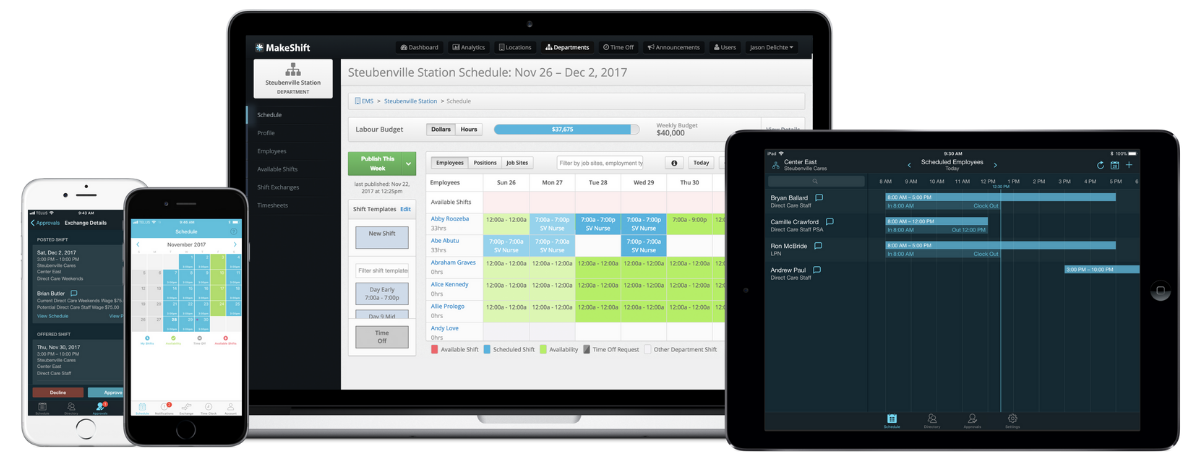“Burnout is nature’s way of telling you you’ve been going through the motions [but] your soul has departed.” – Sam Keen
Unfortunately, workplace fatigue and burnout are at an all-time high.
And it’s no wonder with the ongoing labor shortage — the latest data shows the U.S. has 9.5 million job openings but only 6.5 million unemployed workers.
Picture this — if every unemployed person in the country found a job, we’d still have nearly 3 million open jobs.
Businesses are having to do more with less, and many shift workers are burning the candle at both ends to keep up.
According to the National Safety Council, more than 69% of workers have experienced some degree of fatigue at work.
Today, we’ll teach you how to reduce employee stress and fatigue by prioritizing well-being. We’ve got 11 strategies to upgrade your culture to create more workplace harmony while squashing fatigue at its core.
- Fatigue in the Workplace is Becoming the Norm
- 11 Strategies to Manage Employee Fatigue
- FAQ
- How MakeShift Heads Off Employee Fatigue Before It Happens
- Get a Handle On Workplace Fatigue Today
Is Fatigue in the Workplace the New Norm?
Retail employees, hotel desk clerks, and hospital RNs regularly log extra overtime to cover shifts because there aren’t enough staff members to rotate shifts appropriately.
And those employees can only work so many double and triple shifts before they hit a wall.
The problem of workplace fatigue has been recognized as a public health crisis.
In many companies, workers’ efforts are rewarded with more and more work instead of receiving appropriate support to prevent burnout.
And to make matters worse, they keep overdelivering and stepping in where needed, which is a recipe for physical and mental exhaustion.
11 Strategies to Manage Employee Fatigue
The secret sauce of managing or, better yet, preventing workplace fatigue is revamping your company culture.
Ask yourself these questions:
- Do you regularly reward employees who run themselves into the ground for your business?
- Are you guilty of letting staff members rack up excessive overtime just to keep shifts covered?
We get it — shifts have to be covered, or the show can’t go on.
However, it’s time to do things differently. You can manage your business while prioritizing employee well-being to stave off fatigue and exhaustion.
Try a few (or all) of these 11 strategies to manage workplace fatigue by encouraging your staff to care for themselves.
1. Don’t Skip Regular Breaks
We all have a limited pool of physical and mental energy. When our “energy batteries” run low, we feel depleted, exhausted, and stressed out.
Even when you’re slammed, make sure your staff takes short breaks throughout the day to breathe.
A quick walk, a stretch, or a moment away from the madness can do wonders.
It’s easy to feel like you don’t have time for employee breaks. However you feel about breaks will come across in your attitude based on these stats:
- 22% of workers feel judged when they take a break from work in the middle of the day.
- 39% of workers only occasionally, rarely, or never take a break.
- 94% of employees who take breaks feel like they have a refreshed perspective on work.
- 90% of employees believe regular breaks boost their mood.

- Two 15-minute breaks can improve employee productivity by 2.85 hours a week or 1.4 hours a month.
- 9 in 10 employees were likelier to stay at a job if their managers encouraged taking breaks.
2. Adjust Lighting & Environment
Ensure your workplace has adequate natural light and comfortable temperatures.
A Cornell study tested office temperatures and found that when temps were low (68 degrees or 20 degrees Celsius), employees made 44% more mistakes than at optimal room temperatures (77 degrees or 25 degrees Celsius).
Studies have found that lighting impacts and even alter moods. Natural light is a significant factor in promoting positive moods in the workplace. A well-lit environment can reduce eye strain and fatigue, making it easier for employees to stay focused and energized.
Want your workplace to feel lit? Try this:
Maximize natural light — Whenever possible, maximize the use of natural light. Achieve this by strategically placing windows, skylights, or translucent wall panels.
- Are your employees deskless workers? Use natural lighting in breakrooms.
- Call center workers would benefit from natural light since they’re tied to their headsets.
3. Promote Work-Life Balance
Encourage your employees to maintain a healthy balance between work and their personal life. This means respecting their off-hours and not expecting them to be available 24/7.

Today’s workers expect flexibility. 65% of employees say the pandemic made them rethink the place work should have in their lives.
Many employees can become mentally and physically fatigued if they constantly feel the lines between work and personal life are blurred.
Walk the talk of work-life balance with these tips:
- Flexible work arrangements — Offer flexible work hours, remote work options, or compressed work weeks so employees can better manage their personal and professional responsibilities.
- Encourage time off—Ensure employees feel comfortable taking vacation time and encourage them to disconnect from work during this time. Implement policies that discourage after-hours work communications.
- Provide support & resources — Help employees manage their work and personal lives by providing support and resources like:
- Employee assistance programs
- Stress management workshops
- Access to childcare services
4. Provide Flexible Scheduling Options
Flexible work hours or remote work options can help employees manage their energy levels and reduce fatigue.
Use scheduling software to easily offer multiple scheduling options.
An AI-powered scheduling platform can do the heavy lifting of scheduling to ensure shifts are covered, and employees' preferences are honored — you won’t even break a sweat.

In a Skynova study, over 36% of surveyed employees valued their flexible schedule over PTO, and almost half said having a flexible schedule trumps salary.
Money’s great, but the real flex these days is time freedom — offer your employees that freedom with these flexible schedule options:
- Flextime — Employees can choose their start and end times as long as they complete their required hours. For example, early birds might prefer to start early and finish early, while night owls might opt for a later schedule.
- Compressed workweeks — Employees work longer hours but fewer days, allowing for an extra day off. A typical example is working four 10-hour days with a 3-day weekend.
- Remote work — Allowing employees to work from home or another location can reduce commute times and provide a more comfortable work environment, increasing productivity and reducing fatigue.
- Part-time hours — Offering part-time positions or reduced hours can accommodate employees with other commitments or those seeking a better work-life balance.
- Job sharing — 2 employees share the responsibilities of one full-time position, splitting the hours and workload. This can be an excellent solution for employees with kids who need more flexibility.
- Staggered shifts — Employees have different start, break, and end times, which can help reduce overcrowding and overstaffing in the workplace and accommodate personal schedules.
- Annualized hours — Employees have a set number of hours to work over the year, but there's flexibility in how those hours are distributed, allowing for busier and quieter periods.
- Time off in lieu — Employees can take time off to compensate for extra hours worked, ensuring they're not overworked and have time to rest and recharge.
5. Develop a Supportive Company Culture
Cultivate a culture where employees feel comfortable discussing their workload, mental health, taking time off, and any fatigue-related issues. Open communication can lead to less employee fatigue because there’s no stigma in talking about it.
Culture matters.
- 15% of job seekers turned down a job because of the company’s culture
- Company culture is an important factor for 46% of job seekers.
Squash the stigma related to overwork and fatigue with these options:
- Regular individual check-ins
- Employee surveys
- Group support
- Even wearable devices that monitor stress levels
6. Monitor Workloads
Keep an eye on your team members' workloads. Overloading employees will inevitably lead to fatigue and plunging productivity.
How do you make time to monitor workloads? Try these tips:
- Use AI support — An AI-based project management tool could analyze the current workload, deadlines, and employee capacity and allocate tasks that minimize stress and maximize efficiency.
- Survey says… — Conduct anonymous surveys to gauge employees' feelings about their workload and overall well-being. This can provide insights into areas that may need attention.
- Teach prioritization — Help employees prioritize their tasks based on urgency and importance. This can prevent them from feeling overwhelmed by ensuring they focus on what's most critical.
- Open-door policy — Foster an environment where employees feel comfortable raising concerns about their workload. Let them know it's okay to speak up if they feel stretched too thin.
7. Let’s Get Physical
Encourage physical activity with perks like a gym membership discount or an organized group walk when shifts end. Exercise boosts energy levels and wards off work fatigue.
Forward-thinking leaders know employee well-being directly impacts their company’s success.
Companies with employee programs focused on health and balance cut absenteeism by 25% and boosted productivity by 32%.
Encourage your staff to get moving with these ideas:
- Organize group activities — Host regular group activities like walking clubs, yoga classes, or cycling groups.
- Incentivize — Offer incentives for participation in physical activities. Think about what your employees want — gift cards, extra vacation days, or recognition in company communications.
- Create challenges — Set up friendly competitions or challenges, like step-count contests or fitness challenges, with prizes for winners or participants.
- Offer subsidies or discounts—To make physical activities more accessible and affordable, offer subsidies or discounts on gym memberships, fitness classes, or sports leagues.
- Encourage active commuting — Promote biking, walking, or using public transport to work. Make sure your workplace has bike racks, showers, and locker rooms to support active commuting.
- Educate & motivate — Host workshops or seminars on the benefits of physical activity and how to work it into daily routines. Invite fitness experts or health professionals to speak.
- Create a supportive environment — Ensure your workplace culture supports and values physical activity. Lead by example, with management participating in activities and promoting a healthy lifestyle.
- Flexible scheduling — We’re reiterating the importance of flexible work hours so employees can fit physical activities into their schedules.
8. Promote Healthy Eating
Make healthy snacks or meals accessible in the workplace. Proper nutrition helps sustain energy levels throughout the day.
To shine the spotlight on good nutrition, try these tips:
- Lead by example — Management and leadership should model healthy eating habits. Seeing company leaders prioritize nutrition can inspire employees to do the same.
- Provide healthy Options — Stock the office kitchen or vending machines with healthy snacks like fruits, vegetables, nuts, and whole-grain options. Ensure that any catered meetings or events include nutritious choices.
- Educate employees— Host workshops, seminars, or lunch-and-learn sessions about nutrition, healthy eating habits, meal prep, and recipe sharing. Bring in a nutritionist or dietitian to provide expert advice and answer questions. Better yet, create an online module so employees can work through the info on their own time.
- Preach hydration — Provide easy access to water, such as water coolers or filtered water stations. Provide reusable water bottles or offer them at a discounted price.
- Offer healthy eating resources — Provide healthy eating guides, nutritional information, and links to reputable health websites to help employees make informed food choices.
9. Educate About Sleep Hygiene
Did you know many Americans log extra hours from home besides the usual 9-5 workday?
This trend seems to be affecting employees’ sleep.
When work schedules get hectic, and stress levels rise, it can mess with sleep patterns. When you’re sleep-deprived, you feel tired, less motivated, and struggle to focus.
Poor sleep quality leads to mental fatigue, which leads to a decline in:
- Alertness
- Learning
- Memory
- Critical thinking
- Executing work
29.9% of American employees report sleeping less than 6 hours a night. The number was even higher for managers and entrepreneurs — a whopping 40.5% are getting less than 6 hours of nightly snooze time.

A well-rested team is a more energetic and productive one. To encourage good sleep habits, share these tips on improving sleep quality.
- Set your sleep schedule — Have a fixed wake-up time, prioritize sleep over pulling an all-nighter, and keep naps short (under 20 minutes).
- Follow a nightly routine — Maintain a consistent bedtime routine. Schedule 30 minutes for winding down and unplugging from electronics. Test what else most relaxes you (ex, dim lighting, reading, brown noise, meditation…).
- Cultivate daily healthy habits — Prioritize good nutrition, daily exercise, and natural light exposure. Cut down on afternoon caffeine intake and go easy on the booze at night.
- Prime your bedroom for sleep — Invest in comfortable bedding, keep your room cool, block out light, and try infusing calming scents like lavender.
10. Recognize & Reward
Acknowledge your team’s hard work and show your appreciation with rewards.
Feeling valued can boost employee morale and reduce feelings of physical and mental fatigue.
Develop a recognition program that celebrates both big achievements and small wins.
Offer personalized rewards that resonate with employees' interests and needs.
Your staff wants to know you appreciate their effort.
- 83.6% of employees feel recognition affects their motivation to succeed at work.
- 77.9% of employees say they’d be more productive if recognized often.

The sky’s the limit when it comes to offering kudos to your staff — get creative.
We’ve kicked off the brainstorming session with a few ideas:
- Peer-to-peer recognition
- Company swag
- Shout outs
- Extra PTO
- Gift cards
- Adventure days
11. Promote Stress-Reduction Techniques
Offer resources or workshops on stress management, like meditation or yoga classes.
Chronic stress is a major contributor to employee burnout and fatigue.
Chances are many of your employees are stressed out.
83% of U.S. workers suffer from work-related stress, and 54% of workers say work stress bleeds over into their home life.
These stress-reducing techniques can help your employees kick stress to the curb:
- Mindfulness & meditation workshops — Offer workshops or classes on mindfulness and meditation techniques. These techniques can help employees focus on the present moment, reduce stress, and improve their well-being.
- Yoga & stretching sessions — Organize regular yoga or stretching sessions, either in-person or virtually. Yoga helps reduce physical tension and mental stress while promoting flexibility and relaxation.
- Stress management workshops — Host workshops that teach employees how to identify stressors, manage stress effectively, and develop coping strategies. Topics can include time management, problem-solving, and setting boundaries.
- Employee assistance programs (EAPs) — Provide access to EAPs that offer counseling and support services for employees dealing with stress, anxiety, and other personal or work-related issues.
FAQ
How do you deal with fatigue in the workplace?
To deal with fatigue at work, take breaks, get enough sleep, eat healthy meals, and stay active.
Why do I feel so fatigued at work?
Feeling tired at work can happen for many reasons, like not getting enough sleep, being stressed and overworked, or sitting too long without moving around.
What are the red flags for fatigue?
Red flags for fatigue include feeling tired even after sleeping, having trouble concentrating, feeling moody or irritable, and having difficulty remembering things or concentrating.
What are examples of fatigue in the workplace?
Examples of fatigue at work can include yawning a lot, feeling sluggish, having difficulty staying focused, and feeling like you need a gallon of coffee or energy drinks to stay awake.
How MakeShift Heads Off Employee Fatigue Before It Happens
MakeShift’s people-centric approach makes it easy to manage and create shift schedules that mesh with your employees’ lives to prevent workplace fatigue.
MakeShift goes beyond scheduling. We offer a smarter, more intuitive solution that promotes overall employee well-being and a workplace vibe of cohesiveness through:
- Streamlined Scheduling — Quickly create and modify schedules based on your staffing needs. You’ll be able to manage schedule planning better and honor your team’s shift preferences.

- Efficient Communication — Facilitates easy communication between managers and employees regarding scheduling concerns, shift changes, or requests. Effective communication through the platform strengthens relationships, builds trust, and contributes to less stress associated with work schedules.

- AI-powered Scheduling platform — ShiftMate AI offers 24/7 scheduling suggestions in seconds based on historical data and employee preference. Workforce forecasting prevents under or overstaffing, reducing employee workload stress.

- Enhanced employee engagement — Employees can view their schedules, request time off, and swap shifts. This can help improve employee engagement, reducing fatigue associated with work.

- Data-driven insights — Reporting features allow you to track employee productivity, attendance, and other metrics. This can help you identify areas for improvement and make informed decisions about staffing levels to ensure your staff isn’t overwhelmed or overworked.

- On-the-go accessibility — Accessible on smartphones, allowing for on-the-go schedule management. A schedule in their pocket enhances flexibility and convenience for staff and managers.

Get a Handle On Workplace Fatigue Today
You don’t have to accept that overworked, fatigued employees are part of today’s short-handed businesses.
Instead, you can choose to lead by example by prioritizing good mental and physical health and revamping your company culture to address employee fatigue.
You can still get the job done by utilizing tech to create smarter schedules that support your employees and cover shifts adequately.
And the good news — you don’t have to do it alone. Let MakeShift support you and your staff with smart scheduling that helps avoid workplace fatigue. Schedule your free demo today.








